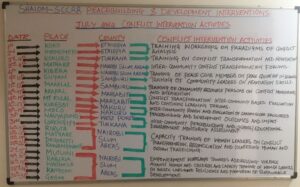By Godfrey Okoth Onyango
SCCRR Assistant Program Manager
Loiyangalani has been in the public limelight for all the good reasons. Located about 760Km north of Nairobi on the southeastern shores of Lake Turkana, the town has in the recent past played host to the Lake Turkana Cultural Festival, which is an annual event that displays the glamor of the cultural diversity that is exhibited by communities living in its environs. Recently, a huge delegation of Kenyan government officials, local and international investors pitched tent in Loiyangalani District (particularly at Sarima) for the grand opening of the Wind Power Project, which is under the management of Lake Turkana Wind Power Limited and which is expected to ease the national demand for power by injecting an extra 310 megawatts of energy into the national grid. The waters of Lake Turkana has also created good fortunes for Loiyangalani since the fish harvested from the lake finds its way into local markets as far as Nairobi. Due to its proximity to the lake, a number of pastoralists from neighboring counties have migrated there in search of pasture and water for their livestock. However, there are significant indicators and issues of conflicts surfacing.
Underneath the fame and the beauty that characterize Loiyangalani is a situation that seems to be taking its greatest toll on the development of the district that bears great potentiality of becoming one of the prime Northern Kenya’s tourism and economic hub. This situation is the interethnic conflict among the Turkana, Samburu, Rendille, El Molo and the Gabbra communities. The Turkana and the Samburu for instance have been up in arms against each other due to misunderstanding over existing territorial boundaries, ethnic hatred and alleged negative influence caused by groups of people that migrate into Loiyangalani from neighboring counties of Samburu and Turkana. Lately, the conflict between the Turkana and Samburu has been exacerbated by the establishment of the wind power project. Instead of presenting potentialities for development and a good life for the locals, the project is slowly turning into a curse and a reason for fierce battle between the Turkana, Samburu and the Rendille since each community lays claim on the territory under which the project is located and therefore demanding a bigger share of the benefits that come from it.
Signs of unrest between the communities are still very visible in the on and off disruption of activities of Lake Turkana Wind Power Limited, the closure of the Marsabit-Loiyangalani road at Sarima and the occasional attack and killing between the Samburu or Turkana. In the evening of 12th October 2015, an elderly man was shot and killed in Loiyangalani town under unclear circumstances by unknown youths. This killing sparked a massive protest in Loiyangalani town by people the next day, leading to the closure of shops, destruction of property and displacement of a massive number of people from their homes.
In a bid to kick start the process of preventing the visible signs of interethnic conflict in Loiyangalani, Shalom Center for Conflict Resolution and Reconciliation set off for the lakeside town with an emphatic methodology of peace making for the local leaders. The Shalom team met lots of frustration from the locals at the beginning of the workshops with occasional interjections which were often an expression of the loss of hope in ever attaining peace.
However after taking moments to explain the methodology of SCCRR, the bottom-up approach that Shalom intended to adopt in conflict intervention, and the participatory approach that the team took in conducting the training, there was a significant restoration of hope and a visible change of attitude and receptivity among the leaders who were in attendance. Indeed at the end of the first day of the workshop, Mr. Joseph, a head teacher at a primary school in Mt. Kulal, said: “It is in order that you came here at this time. These people have lost hope in peace and they are at the moment preparing their morans (warriors) to attack. I am confident that your coming here has created a good opportunity for our people to rethink the possibilities of peace.”
The massive expression of support to pursue peace once more among both the Turkana, Samburu, Rendille and El-molo communities was manifested in the resolution among the four communities to establish a peace committee for action made up of 25 most influential community members who will be drawn from all the ethnic communities and whose mandate will be to initiate, participate in and monitor the peace process in Loiyangalani District in close collaboration with SCCRR and the Catholic Diocese of Marsabit. Shalom looks forward to enhancing the conflict intervention capacities of the communities in Loiyangalani District and with the commitment of all the relevant stakeholders from the grassroots, there is hope for a more sustainable peace for the region. Another substantial Shalom intervention is on the road to bearing fruit.

Participants in Loiyangalani after the Shalom workshop.

